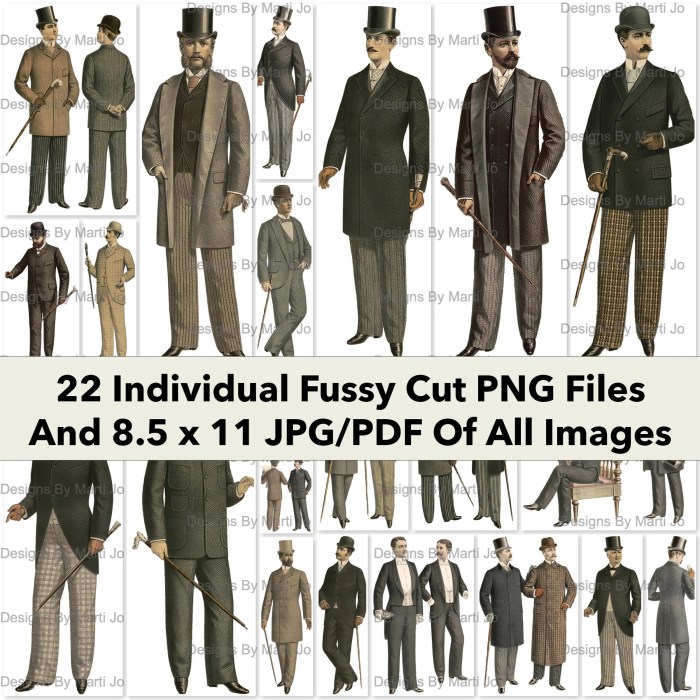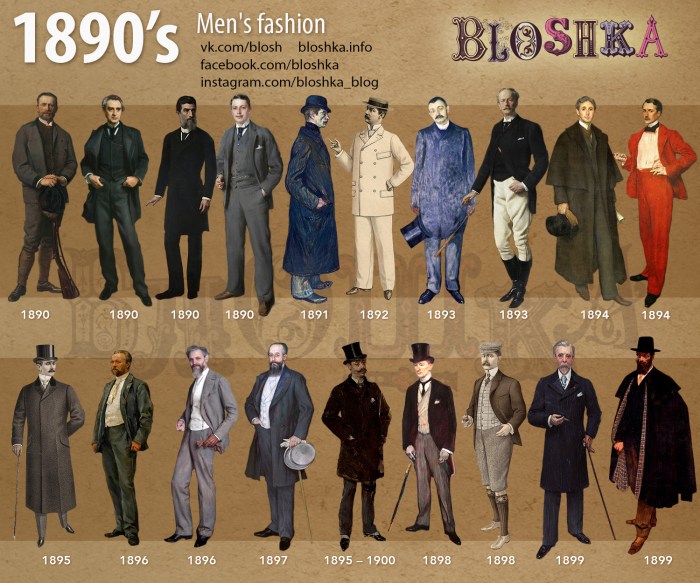Mens Fashion 1890 A Gentlemans Style Guide
Men’s Fashion in 1890

Source: etsystatic.com
Mens fashion 1890 – The year 1890 witnessed a distinct style in men’s fashion, reflecting both technological advancements and societal hierarchies. Silhouettes, fabrics, and accessories all played a significant role in conveying a man’s social standing and personal taste. This exploration delves into the nuances of men’s attire during this fascinating era.
Men’s Clothing Styles of 1890, Mens fashion 1890
Men’s suits in 1890 were characterized by a long, fitted silhouette. The jackets were typically single-breasted, often featuring a notched lapel, and extended to the hip or slightly below. Trousers were high-waisted and fairly loose-fitting, often worn with a slightly cuffed hem. The overall effect was one of elegance and formality, although variations existed based on social class and occasion.
Common fabrics included wool, particularly worsted wool for suits, and tweed for more casual wear. Linen was popular for warmer months, often used for shirts and lighter suits. Silk was a luxurious choice, employed for accessories such as ties and pocket squares. Velvet was also used, particularly for evening wear.
Accessories were essential components of a man’s attire. Top hats remained a staple, particularly for formal occasions. Bowler hats and fedoras were also popular choices, offering a more casual yet stylish alternative. Ties, typically cravats or bow ties, were worn with most outfits, adding a touch of personality. Pocket watches, often housed in ornate cases, were carried in waistcoats, symbolizing both practicality and status.
| Social Class | Typical Attire | Fabrics | Accessories |
|---|---|---|---|
| Upper Class | Tailored suits, frock coats, top hats | Fine worsted wool, silk, linen | Top hats, canes, pocket watches, cufflinks, expensive gloves |
| Working Class | Work shirts, trousers, vests, caps | Durable cotton, denim, tweed | Simple caps, work gloves, pocket knives |
The Influence of Social Class on Fashion
Social status profoundly impacted clothing choices in 1890. The quality of fabrics, the tailoring of garments, and the choice of accessories all served as visible markers of a man’s position in society. Wealthy businessmen favored luxurious materials and impeccably tailored suits, while laborers wore more durable and practical clothing suited to their work.
Wealthy businessmen often sported three-piece suits made from fine worsted wool, paired with polished shoes and expensive accessories. In contrast, laborers’ attire reflected their working conditions, prioritizing functionality and durability over style. Their clothing was typically made from coarser fabrics and was designed for practicality and resilience.
Uniforms played a significant role in shaping the visual landscape of 1890s menswear. Military uniforms, police uniforms, and even the livery of servants all contributed to the overall visual tapestry of the era, showcasing different social roles and hierarchies.
Visual Representation: Imagine three figures. The first, a wealthy businessman, is dressed in a dark, impeccably tailored three-piece suit of fine worsted wool, a crisp white shirt, a silk tie, and polished leather shoes. He carries a cane and a top hat. The second, a middle-class clerk, wears a simpler, single-breasted suit made of a less expensive wool, a less formal tie, and slightly worn shoes.
He wears a bowler hat. The third, a laborer, is dressed in sturdy work trousers, a denim shirt, and strong boots. He wears a simple cap and carries a lunch pail.
Evolution of Men’s Hairstyles and Grooming
Men’s hairstyles in 1890 were generally neat and conservative. Short, neatly trimmed hair was common, often parted on the side and combed back. Longer hair was less prevalent, but some men might sport slightly longer hair, styled with pomade for a sleek look. Mustaches were incredibly popular, ranging from neatly trimmed handlebar mustaches to fuller, more natural styles.
Beards were also common, although shorter, trimmed beards were more fashionable than longer, fuller ones.
Men’s fashion in 1890 often featured tailored suits and formal wear, a stark contrast to today’s options. The evolution of menswear is fascinating, and while the styles differed greatly, the underlying desire for comfortable and stylish clothing remains. For a modern take on relaxed spring attire, explore current trends in men’s spring casual fashion , which offers a refreshing perspective compared to the more structured garments of the late 19th century.
The enduring appeal of well-dressed men, however, transcends eras.
Grooming products included pomades, hair tonics, and shaving soaps. Men typically used razors, often straight razors, for shaving. The overall grooming aesthetic emphasized neatness and cleanliness, reflecting the societal values of the time.
- Short, side-parted hair: Daily combing and the use of pomade for a sleek finish.
- Neatly trimmed mustache: Regular trimming and the use of mustache wax to shape and maintain.
- Short, trimmed beard: Regular trimming and the use of beard oil or balm to soften and condition.
The Impact of Technology on Men’s Fashion

Source: bloshka.info
Advancements in textile manufacturing significantly impacted men’s fashion in 1890. The invention and refinement of the sewing machine led to increased efficiency and lower production costs, making clothing more accessible to a wider range of the population. New weaving techniques allowed for the production of finer and more durable fabrics.
The sewing machine revolutionized the garment industry, enabling faster and more precise stitching. This increased efficiency led to lower production costs, making clothing more affordable. Improvements in textile manufacturing also led to a wider variety of fabrics available to consumers.
A typical day for a tailor in 1890 might involve measuring clients, cutting patterns, hand-stitching intricate details, and using the sewing machine for faster construction. Tools included shears, needles, thimbles, measuring tapes, and the sewing machine itself. His workshop would likely be filled with bolts of fabric, patterns, and the aroma of freshly cut cloth.
Iconic Men’s Fashion Figures of 1890
While pinpointing specific “influencers” in the same way we do today is difficult, certain public figures and artistic representations undoubtedly shaped the perceptions of fashionable menswear. Consider, for instance, the styles associated with upper-class businessmen depicted in contemporary paintings and photographs. These men often set the trends, showcasing tailored suits, fine fabrics, and polished accessories.
One could imagine a wealthy industrialist, always impeccably dressed in dark, tailored suits, perhaps with a carefully groomed mustache and a top hat. Another might be a prominent artist or writer, favoring a more bohemian style, perhaps with a slightly longer, less structured suit and a more artistic use of accessories like scarves or pocket squares. A third might be a military officer, his uniform representing a different form of sophisticated and authoritative style.
These varied representations demonstrate the breadth of “influential” styles, even without specific named individuals dominating the landscape like modern fashion icons.
Question Bank: Mens Fashion 1890
What were some common fabrics used in men’s clothing in 1890?
Wool, tweed, cotton, linen, and silk were prevalent fabrics. Wool was particularly popular for suits and overcoats due to its warmth and durability.
How did the availability of ready-to-wear clothing affect men’s fashion?
Ready-to-wear clothing became more common, making fashionable attire more accessible to the middle and lower classes, though bespoke tailoring remained prestigious.
Were there any notable differences in footwear for different social classes?
Yes, upper-class men often wore leather boots or shoes of finer quality, while working-class men wore more durable, practical footwear like sturdy boots.





















